Cystic Fibrosis: Molecular Pathophysiology, Treatment, and Questions
VerifiedAdded on 2021/04/17
|8
|1489
|158
Report
AI Summary
This report provides a comprehensive overview of Cystic Fibrosis (CF), an epithelial disease characterized by the overproduction of mucus due to CFTR gene mutations. It explores the 3 key features of the disease, focusing on the molecular pathophysiology, particularly the impact on the respiratory, hematopoietic, gastrointestinal, endocrine, and reproductive systems. The report details therapeutic strategies, including gene therapy and the targeting of ion channel abnormalities. Furthermore, it poses key questions about the genetic mutations and protein function of the CFTR protein, suggesting experimental designs such as meta-analysis and RFLP to understand the implications of chromosome deletions and rearrangements and the characterization of the CFTR protein. This report is contributed by a student and is available on Desklib.
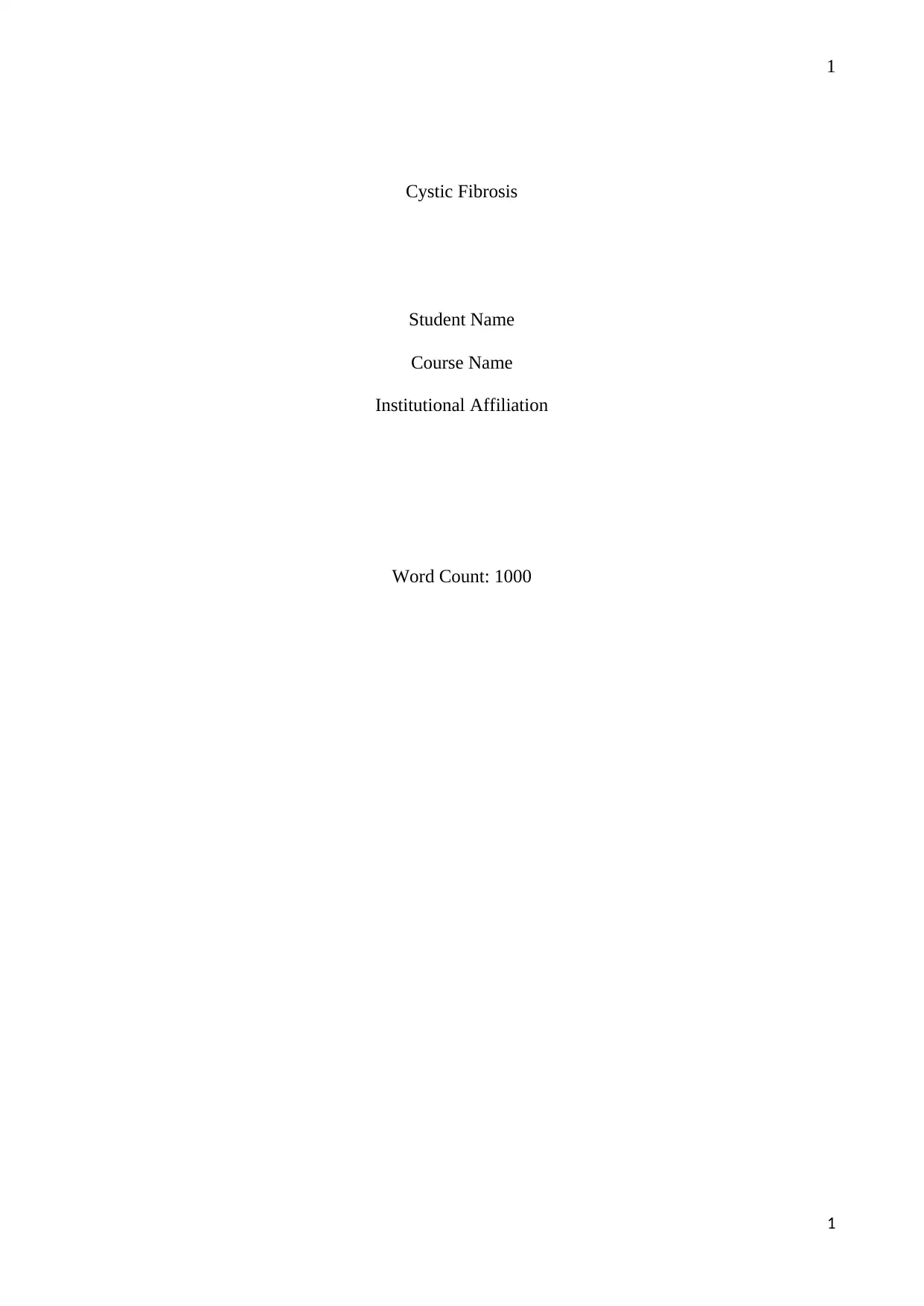
1
Cystic Fibrosis
Student Name
Course Name
Institutional Affiliation
Word Count: 1000
1
Cystic Fibrosis
Student Name
Course Name
Institutional Affiliation
Word Count: 1000
1
Paraphrase This Document
Need a fresh take? Get an instant paraphrase of this document with our AI Paraphraser
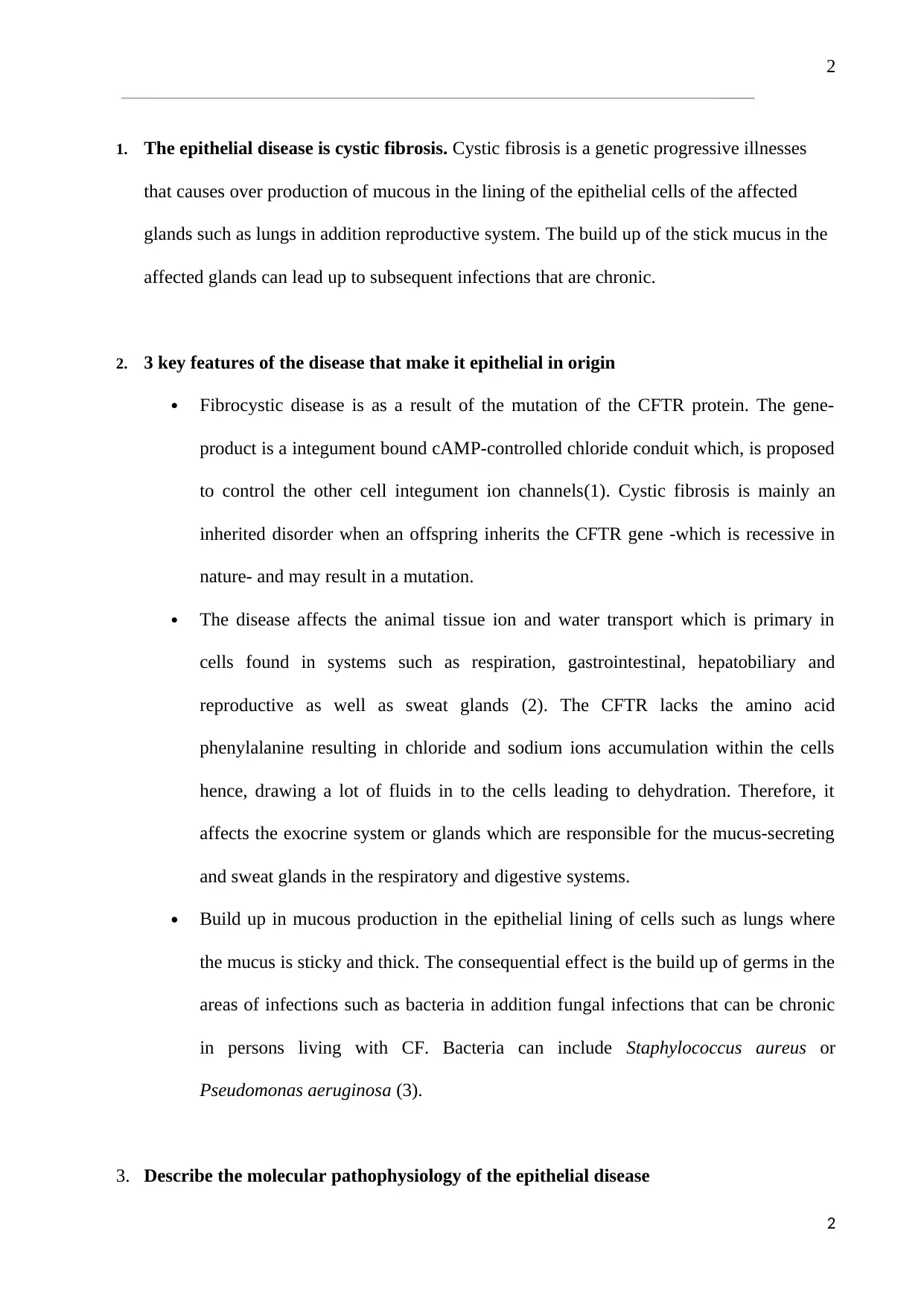
2
1. The epithelial disease is cystic fibrosis. Cystic fibrosis is a genetic progressive illnesses
that causes over production of mucous in the lining of the epithelial cells of the affected
glands such as lungs in addition reproductive system. The build up of the stick mucus in the
affected glands can lead up to subsequent infections that are chronic.
2. 3 key features of the disease that make it epithelial in origin
Fibrocystic disease is as a result of the mutation of the CFTR protein. The gene-
product is a integument bound cAMP-controlled chloride conduit which, is proposed
to control the other cell integument ion channels(1). Cystic fibrosis is mainly an
inherited disorder when an offspring inherits the CFTR gene -which is recessive in
nature- and may result in a mutation.
The disease affects the animal tissue ion and water transport which is primary in
cells found in systems such as respiration, gastrointestinal, hepatobiliary and
reproductive as well as sweat glands (2). The CFTR lacks the amino acid
phenylalanine resulting in chloride and sodium ions accumulation within the cells
hence, drawing a lot of fluids in to the cells leading to dehydration. Therefore, it
affects the exocrine system or glands which are responsible for the mucus-secreting
and sweat glands in the respiratory and digestive systems.
Build up in mucous production in the epithelial lining of cells such as lungs where
the mucus is sticky and thick. The consequential effect is the build up of germs in the
areas of infections such as bacteria in addition fungal infections that can be chronic
in persons living with CF. Bacteria can include Staphylococcus aureus or
Pseudomonas aeruginosa (3).
3. Describe the molecular pathophysiology of the epithelial disease
2
1. The epithelial disease is cystic fibrosis. Cystic fibrosis is a genetic progressive illnesses
that causes over production of mucous in the lining of the epithelial cells of the affected
glands such as lungs in addition reproductive system. The build up of the stick mucus in the
affected glands can lead up to subsequent infections that are chronic.
2. 3 key features of the disease that make it epithelial in origin
Fibrocystic disease is as a result of the mutation of the CFTR protein. The gene-
product is a integument bound cAMP-controlled chloride conduit which, is proposed
to control the other cell integument ion channels(1). Cystic fibrosis is mainly an
inherited disorder when an offspring inherits the CFTR gene -which is recessive in
nature- and may result in a mutation.
The disease affects the animal tissue ion and water transport which is primary in
cells found in systems such as respiration, gastrointestinal, hepatobiliary and
reproductive as well as sweat glands (2). The CFTR lacks the amino acid
phenylalanine resulting in chloride and sodium ions accumulation within the cells
hence, drawing a lot of fluids in to the cells leading to dehydration. Therefore, it
affects the exocrine system or glands which are responsible for the mucus-secreting
and sweat glands in the respiratory and digestive systems.
Build up in mucous production in the epithelial lining of cells such as lungs where
the mucus is sticky and thick. The consequential effect is the build up of germs in the
areas of infections such as bacteria in addition fungal infections that can be chronic
in persons living with CF. Bacteria can include Staphylococcus aureus or
Pseudomonas aeruginosa (3).
3. Describe the molecular pathophysiology of the epithelial disease
2
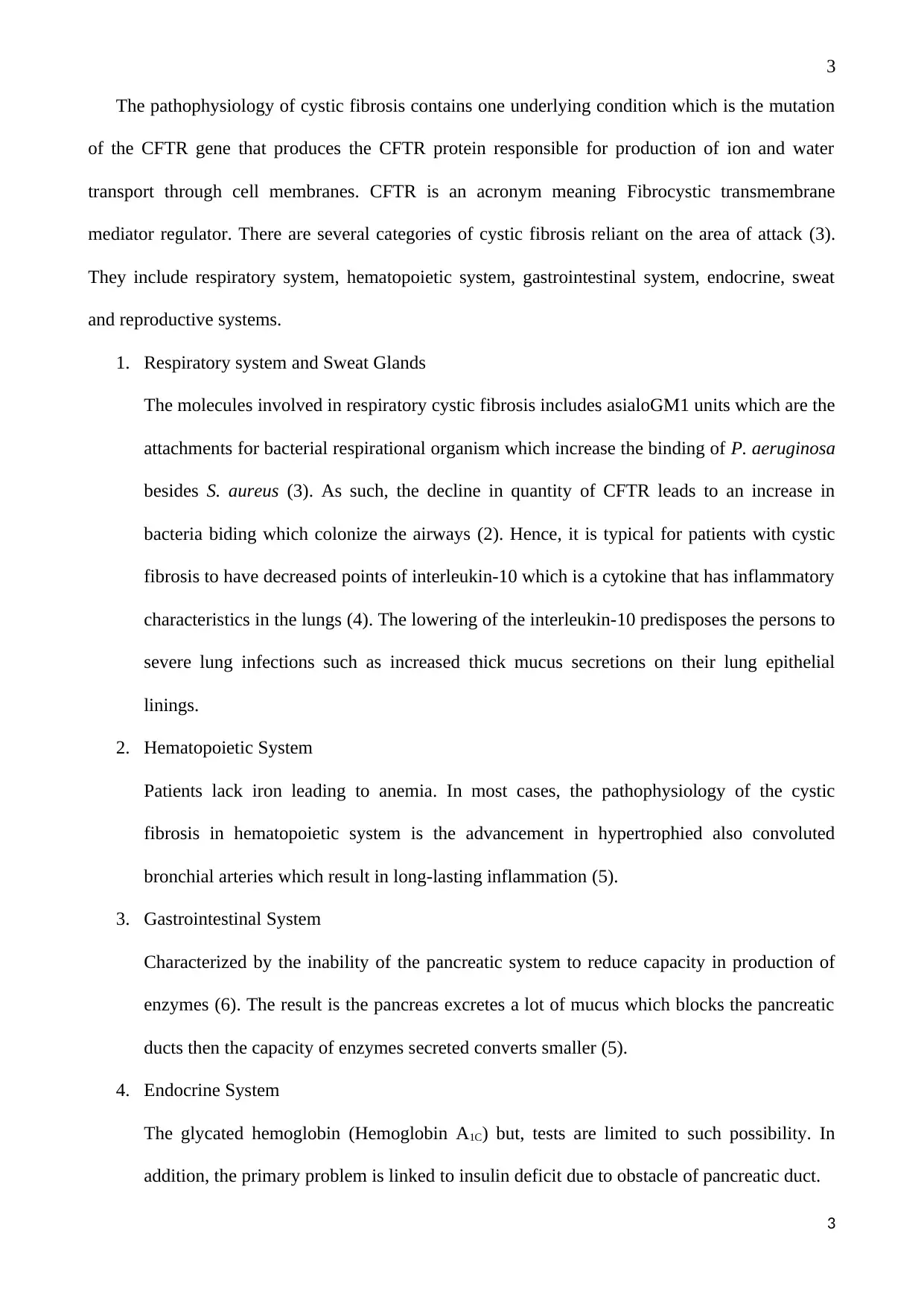
3
The pathophysiology of cystic fibrosis contains one underlying condition which is the mutation
of the CFTR gene that produces the CFTR protein responsible for production of ion and water
transport through cell membranes. CFTR is an acronym meaning Fibrocystic transmembrane
mediator regulator. There are several categories of cystic fibrosis reliant on the area of attack (3).
They include respiratory system, hematopoietic system, gastrointestinal system, endocrine, sweat
and reproductive systems.
1. Respiratory system and Sweat Glands
The molecules involved in respiratory cystic fibrosis includes asialoGM1 units which are the
attachments for bacterial respirational organism which increase the binding of P. aeruginosa
besides S. aureus (3). As such, the decline in quantity of CFTR leads to an increase in
bacteria biding which colonize the airways (2). Hence, it is typical for patients with cystic
fibrosis to have decreased points of interleukin-10 which is a cytokine that has inflammatory
characteristics in the lungs (4). The lowering of the interleukin-10 predisposes the persons to
severe lung infections such as increased thick mucus secretions on their lung epithelial
linings.
2. Hematopoietic System
Patients lack iron leading to anemia. In most cases, the pathophysiology of the cystic
fibrosis in hematopoietic system is the advancement in hypertrophied also convoluted
bronchial arteries which result in long-lasting inflammation (5).
3. Gastrointestinal System
Characterized by the inability of the pancreatic system to reduce capacity in production of
enzymes (6). The result is the pancreas excretes a lot of mucus which blocks the pancreatic
ducts then the capacity of enzymes secreted converts smaller (5).
4. Endocrine System
The glycated hemoglobin (Hemoglobin A1C) but, tests are limited to such possibility. In
addition, the primary problem is linked to insulin deficit due to obstacle of pancreatic duct.
3
The pathophysiology of cystic fibrosis contains one underlying condition which is the mutation
of the CFTR gene that produces the CFTR protein responsible for production of ion and water
transport through cell membranes. CFTR is an acronym meaning Fibrocystic transmembrane
mediator regulator. There are several categories of cystic fibrosis reliant on the area of attack (3).
They include respiratory system, hematopoietic system, gastrointestinal system, endocrine, sweat
and reproductive systems.
1. Respiratory system and Sweat Glands
The molecules involved in respiratory cystic fibrosis includes asialoGM1 units which are the
attachments for bacterial respirational organism which increase the binding of P. aeruginosa
besides S. aureus (3). As such, the decline in quantity of CFTR leads to an increase in
bacteria biding which colonize the airways (2). Hence, it is typical for patients with cystic
fibrosis to have decreased points of interleukin-10 which is a cytokine that has inflammatory
characteristics in the lungs (4). The lowering of the interleukin-10 predisposes the persons to
severe lung infections such as increased thick mucus secretions on their lung epithelial
linings.
2. Hematopoietic System
Patients lack iron leading to anemia. In most cases, the pathophysiology of the cystic
fibrosis in hematopoietic system is the advancement in hypertrophied also convoluted
bronchial arteries which result in long-lasting inflammation (5).
3. Gastrointestinal System
Characterized by the inability of the pancreatic system to reduce capacity in production of
enzymes (6). The result is the pancreas excretes a lot of mucus which blocks the pancreatic
ducts then the capacity of enzymes secreted converts smaller (5).
4. Endocrine System
The glycated hemoglobin (Hemoglobin A1C) but, tests are limited to such possibility. In
addition, the primary problem is linked to insulin deficit due to obstacle of pancreatic duct.
3
⊘ This is a preview!⊘
Do you want full access?
Subscribe today to unlock all pages.

Trusted by 1+ million students worldwide
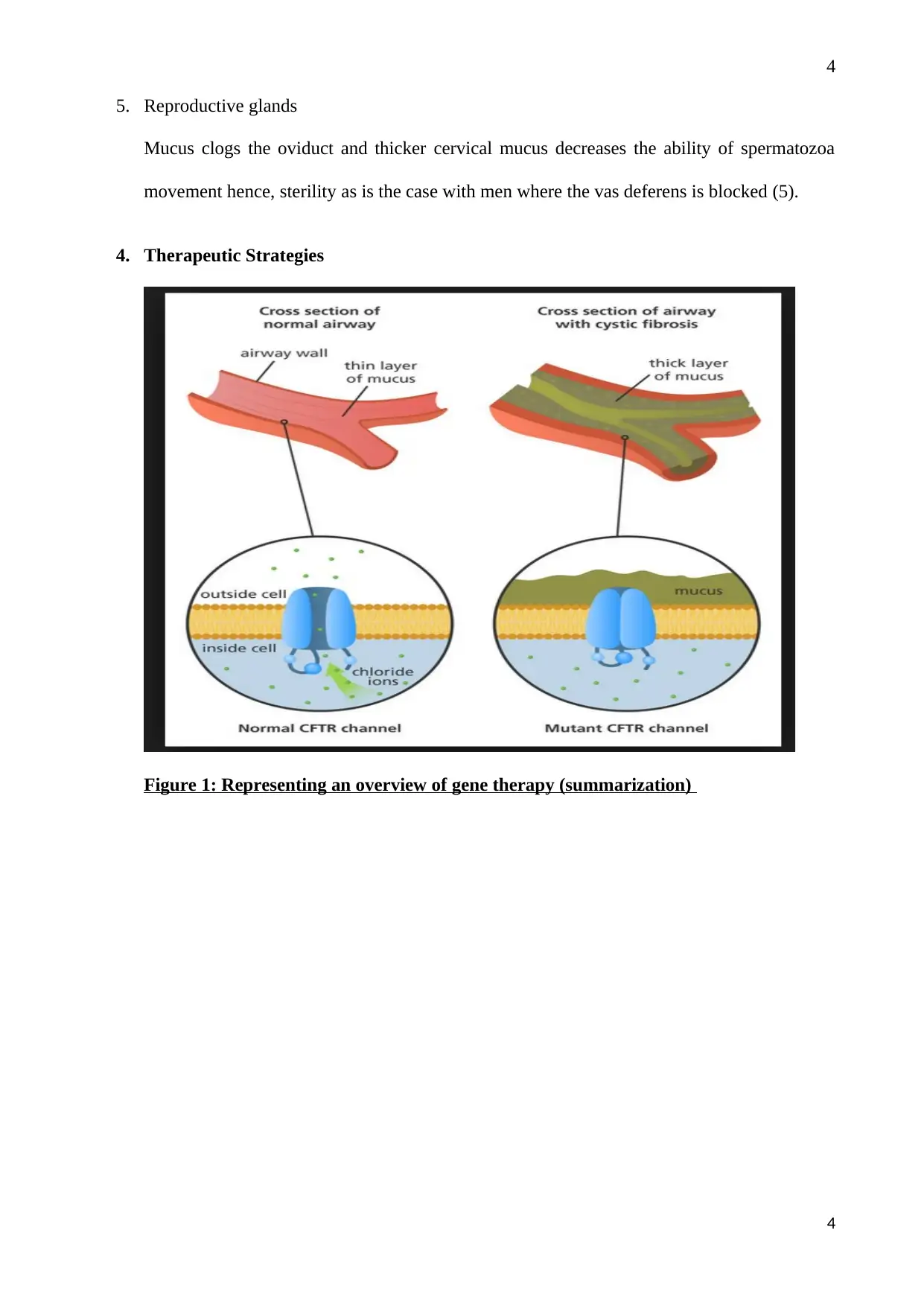
4
5. Reproductive glands
Mucus clogs the oviduct and thicker cervical mucus decreases the ability of spermatozoa
movement hence, sterility as is the case with men where the vas deferens is blocked (5).
4. Therapeutic Strategies
Figure 1: Representing an overview of gene therapy (summarization)
4
5. Reproductive glands
Mucus clogs the oviduct and thicker cervical mucus decreases the ability of spermatozoa
movement hence, sterility as is the case with men where the vas deferens is blocked (5).
4. Therapeutic Strategies
Figure 1: Representing an overview of gene therapy (summarization)
4
Paraphrase This Document
Need a fresh take? Get an instant paraphrase of this document with our AI Paraphraser
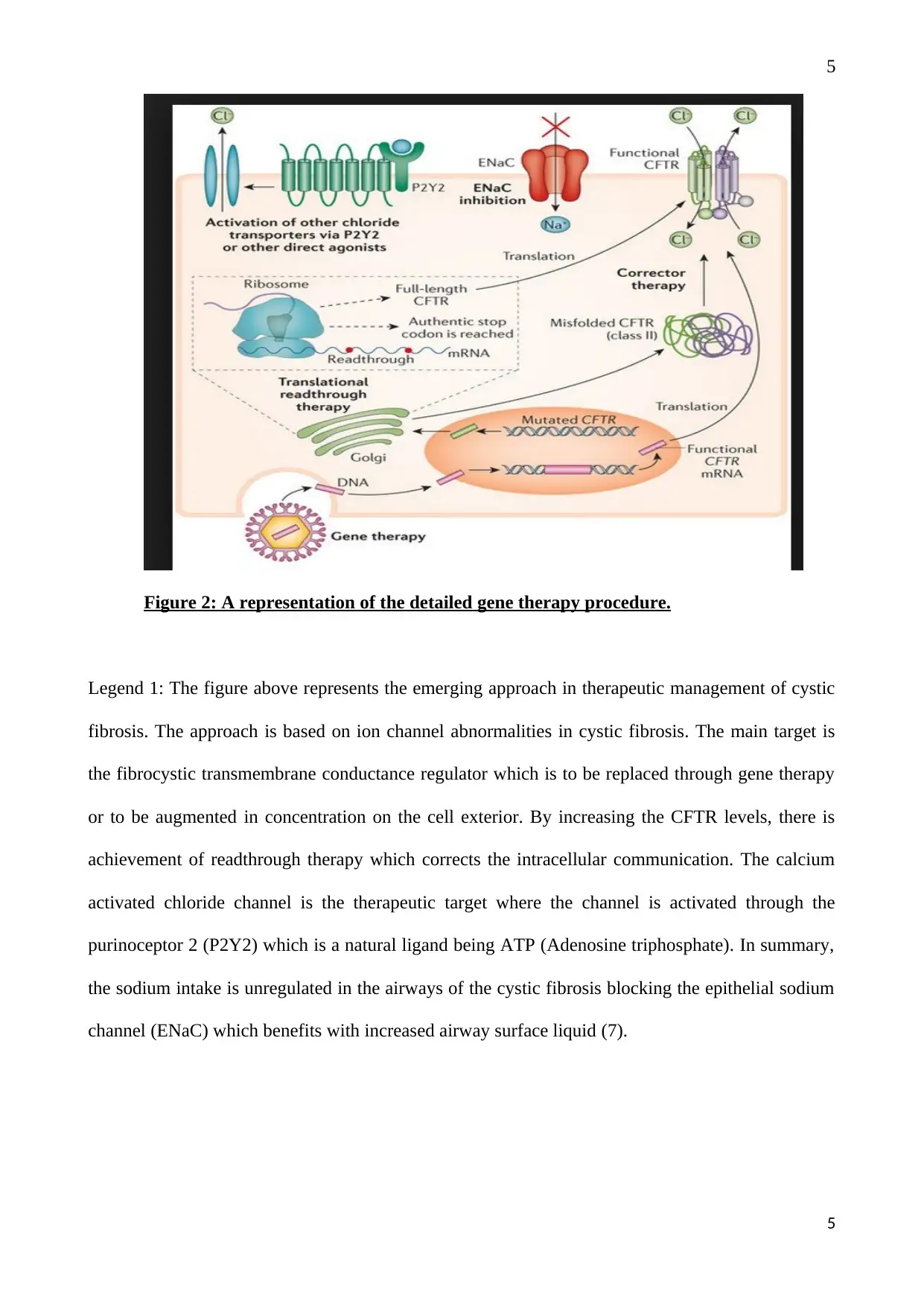
5
Figure 2: A representation of the detailed gene therapy procedure.
Legend 1: The figure above represents the emerging approach in therapeutic management of cystic
fibrosis. The approach is based on ion channel abnormalities in cystic fibrosis. The main target is
the fibrocystic transmembrane conductance regulator which is to be replaced through gene therapy
or to be augmented in concentration on the cell exterior. By increasing the CFTR levels, there is
achievement of readthrough therapy which corrects the intracellular communication. The calcium
activated chloride channel is the therapeutic target where the channel is activated through the
purinoceptor 2 (P2Y2) which is a natural ligand being ATP (Adenosine triphosphate). In summary,
the sodium intake is unregulated in the airways of the cystic fibrosis blocking the epithelial sodium
channel (ENaC) which benefits with increased airway surface liquid (7).
5
Figure 2: A representation of the detailed gene therapy procedure.
Legend 1: The figure above represents the emerging approach in therapeutic management of cystic
fibrosis. The approach is based on ion channel abnormalities in cystic fibrosis. The main target is
the fibrocystic transmembrane conductance regulator which is to be replaced through gene therapy
or to be augmented in concentration on the cell exterior. By increasing the CFTR levels, there is
achievement of readthrough therapy which corrects the intracellular communication. The calcium
activated chloride channel is the therapeutic target where the channel is activated through the
purinoceptor 2 (P2Y2) which is a natural ligand being ATP (Adenosine triphosphate). In summary,
the sodium intake is unregulated in the airways of the cystic fibrosis blocking the epithelial sodium
channel (ENaC) which benefits with increased airway surface liquid (7).
5
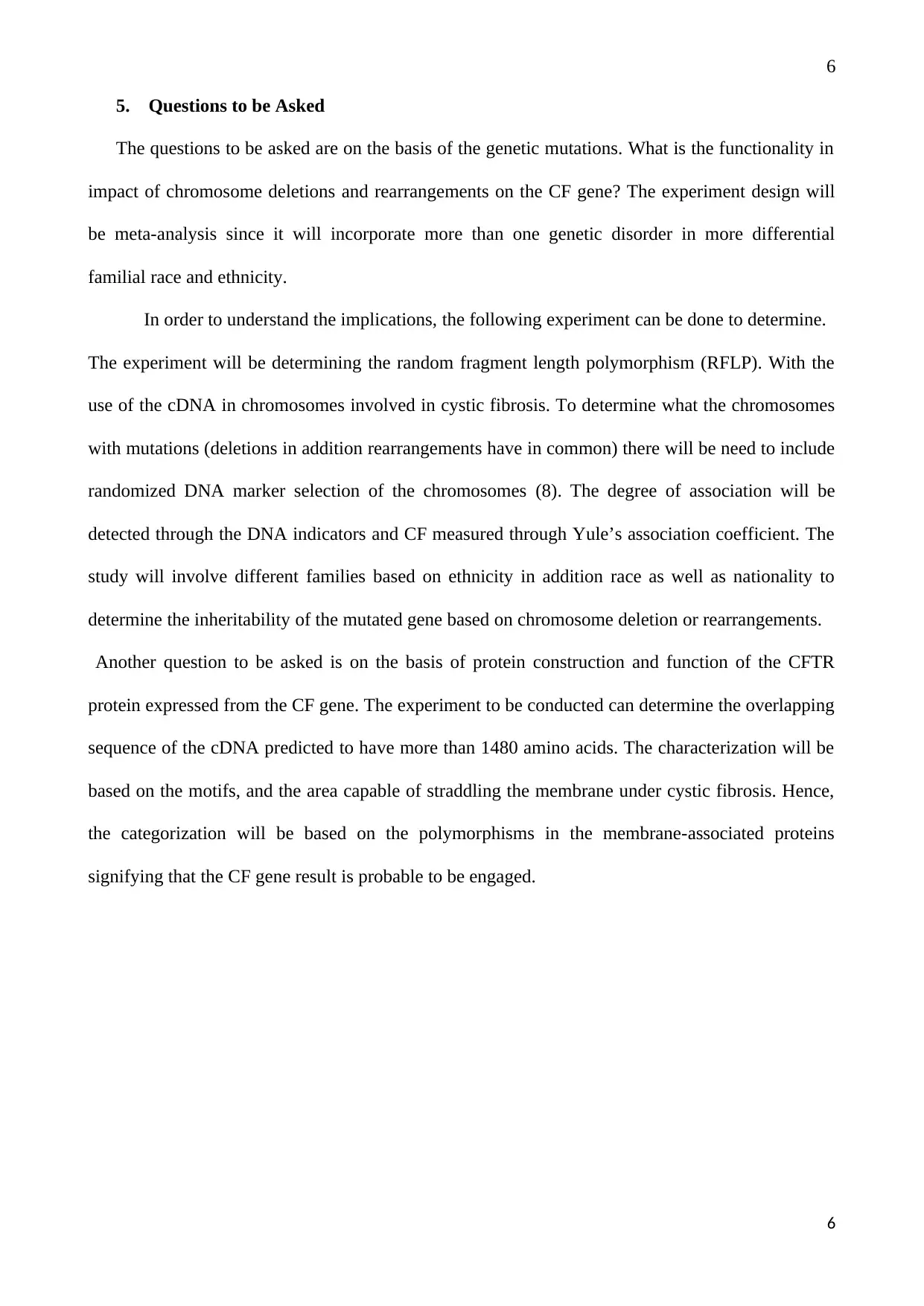
6
5. Questions to be Asked
The questions to be asked are on the basis of the genetic mutations. What is the functionality in
impact of chromosome deletions and rearrangements on the CF gene? The experiment design will
be meta-analysis since it will incorporate more than one genetic disorder in more differential
familial race and ethnicity.
In order to understand the implications, the following experiment can be done to determine.
The experiment will be determining the random fragment length polymorphism (RFLP). With the
use of the cDNA in chromosomes involved in cystic fibrosis. To determine what the chromosomes
with mutations (deletions in addition rearrangements have in common) there will be need to include
randomized DNA marker selection of the chromosomes (8). The degree of association will be
detected through the DNA indicators and CF measured through Yule’s association coefficient. The
study will involve different families based on ethnicity in addition race as well as nationality to
determine the inheritability of the mutated gene based on chromosome deletion or rearrangements.
Another question to be asked is on the basis of protein construction and function of the CFTR
protein expressed from the CF gene. The experiment to be conducted can determine the overlapping
sequence of the cDNA predicted to have more than 1480 amino acids. The characterization will be
based on the motifs, and the area capable of straddling the membrane under cystic fibrosis. Hence,
the categorization will be based on the polymorphisms in the membrane-associated proteins
signifying that the CF gene result is probable to be engaged.
6
5. Questions to be Asked
The questions to be asked are on the basis of the genetic mutations. What is the functionality in
impact of chromosome deletions and rearrangements on the CF gene? The experiment design will
be meta-analysis since it will incorporate more than one genetic disorder in more differential
familial race and ethnicity.
In order to understand the implications, the following experiment can be done to determine.
The experiment will be determining the random fragment length polymorphism (RFLP). With the
use of the cDNA in chromosomes involved in cystic fibrosis. To determine what the chromosomes
with mutations (deletions in addition rearrangements have in common) there will be need to include
randomized DNA marker selection of the chromosomes (8). The degree of association will be
detected through the DNA indicators and CF measured through Yule’s association coefficient. The
study will involve different families based on ethnicity in addition race as well as nationality to
determine the inheritability of the mutated gene based on chromosome deletion or rearrangements.
Another question to be asked is on the basis of protein construction and function of the CFTR
protein expressed from the CF gene. The experiment to be conducted can determine the overlapping
sequence of the cDNA predicted to have more than 1480 amino acids. The characterization will be
based on the motifs, and the area capable of straddling the membrane under cystic fibrosis. Hence,
the categorization will be based on the polymorphisms in the membrane-associated proteins
signifying that the CF gene result is probable to be engaged.
6
⊘ This is a preview!⊘
Do you want full access?
Subscribe today to unlock all pages.

Trusted by 1+ million students worldwide
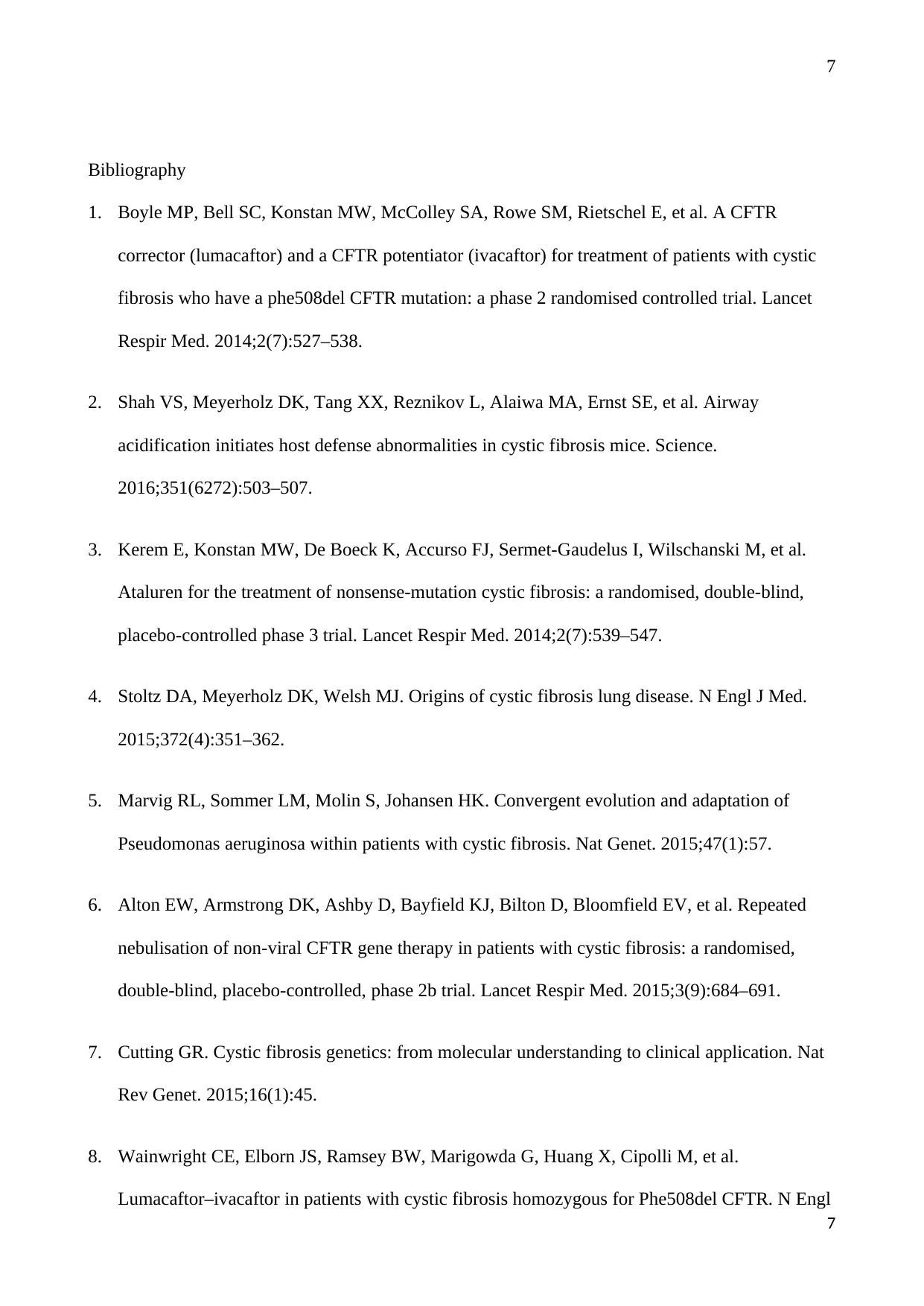
7
Bibliography
1. Boyle MP, Bell SC, Konstan MW, McColley SA, Rowe SM, Rietschel E, et al. A CFTR
corrector (lumacaftor) and a CFTR potentiator (ivacaftor) for treatment of patients with cystic
fibrosis who have a phe508del CFTR mutation: a phase 2 randomised controlled trial. Lancet
Respir Med. 2014;2(7):527–538.
2. Shah VS, Meyerholz DK, Tang XX, Reznikov L, Alaiwa MA, Ernst SE, et al. Airway
acidification initiates host defense abnormalities in cystic fibrosis mice. Science.
2016;351(6272):503–507.
3. Kerem E, Konstan MW, De Boeck K, Accurso FJ, Sermet-Gaudelus I, Wilschanski M, et al.
Ataluren for the treatment of nonsense-mutation cystic fibrosis: a randomised, double-blind,
placebo-controlled phase 3 trial. Lancet Respir Med. 2014;2(7):539–547.
4. Stoltz DA, Meyerholz DK, Welsh MJ. Origins of cystic fibrosis lung disease. N Engl J Med.
2015;372(4):351–362.
5. Marvig RL, Sommer LM, Molin S, Johansen HK. Convergent evolution and adaptation of
Pseudomonas aeruginosa within patients with cystic fibrosis. Nat Genet. 2015;47(1):57.
6. Alton EW, Armstrong DK, Ashby D, Bayfield KJ, Bilton D, Bloomfield EV, et al. Repeated
nebulisation of non-viral CFTR gene therapy in patients with cystic fibrosis: a randomised,
double-blind, placebo-controlled, phase 2b trial. Lancet Respir Med. 2015;3(9):684–691.
7. Cutting GR. Cystic fibrosis genetics: from molecular understanding to clinical application. Nat
Rev Genet. 2015;16(1):45.
8. Wainwright CE, Elborn JS, Ramsey BW, Marigowda G, Huang X, Cipolli M, et al.
Lumacaftor–ivacaftor in patients with cystic fibrosis homozygous for Phe508del CFTR. N Engl
7
Bibliography
1. Boyle MP, Bell SC, Konstan MW, McColley SA, Rowe SM, Rietschel E, et al. A CFTR
corrector (lumacaftor) and a CFTR potentiator (ivacaftor) for treatment of patients with cystic
fibrosis who have a phe508del CFTR mutation: a phase 2 randomised controlled trial. Lancet
Respir Med. 2014;2(7):527–538.
2. Shah VS, Meyerholz DK, Tang XX, Reznikov L, Alaiwa MA, Ernst SE, et al. Airway
acidification initiates host defense abnormalities in cystic fibrosis mice. Science.
2016;351(6272):503–507.
3. Kerem E, Konstan MW, De Boeck K, Accurso FJ, Sermet-Gaudelus I, Wilschanski M, et al.
Ataluren for the treatment of nonsense-mutation cystic fibrosis: a randomised, double-blind,
placebo-controlled phase 3 trial. Lancet Respir Med. 2014;2(7):539–547.
4. Stoltz DA, Meyerholz DK, Welsh MJ. Origins of cystic fibrosis lung disease. N Engl J Med.
2015;372(4):351–362.
5. Marvig RL, Sommer LM, Molin S, Johansen HK. Convergent evolution and adaptation of
Pseudomonas aeruginosa within patients with cystic fibrosis. Nat Genet. 2015;47(1):57.
6. Alton EW, Armstrong DK, Ashby D, Bayfield KJ, Bilton D, Bloomfield EV, et al. Repeated
nebulisation of non-viral CFTR gene therapy in patients with cystic fibrosis: a randomised,
double-blind, placebo-controlled, phase 2b trial. Lancet Respir Med. 2015;3(9):684–691.
7. Cutting GR. Cystic fibrosis genetics: from molecular understanding to clinical application. Nat
Rev Genet. 2015;16(1):45.
8. Wainwright CE, Elborn JS, Ramsey BW, Marigowda G, Huang X, Cipolli M, et al.
Lumacaftor–ivacaftor in patients with cystic fibrosis homozygous for Phe508del CFTR. N Engl
7
Paraphrase This Document
Need a fresh take? Get an instant paraphrase of this document with our AI Paraphraser

8
J Med. 2015;373(3):220–231.
8
J Med. 2015;373(3):220–231.
8
1 out of 8
Related Documents
Your All-in-One AI-Powered Toolkit for Academic Success.
+13062052269
info@desklib.com
Available 24*7 on WhatsApp / Email
![[object Object]](/_next/static/media/star-bottom.7253800d.svg)
Unlock your academic potential
Copyright © 2020–2025 A2Z Services. All Rights Reserved. Developed and managed by ZUCOL.





